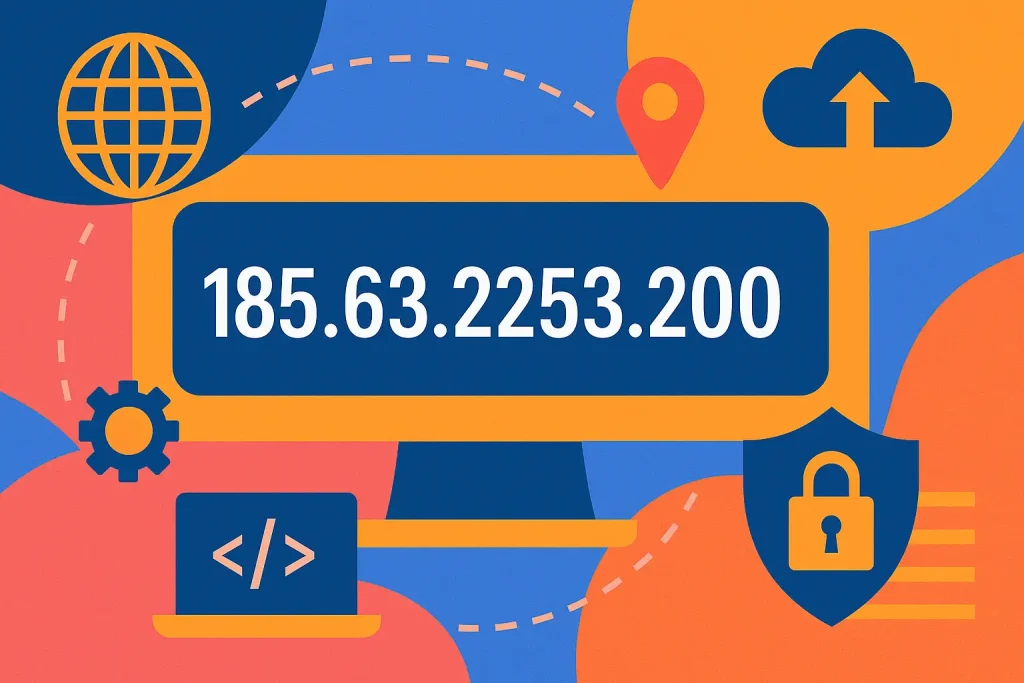
The world of IP addresses is vast and often misunderstood, yet each address tells a story. Among them, 185.63.2253.200 stands out as a curious case. With discussions ranging from cybersecurity to geolocation, this IP has sparked intrigue across forums, analysts, and tech enthusiasts. Whether you’re an IT expert or a digital privacy advocate, understanding such IPs is essential in a world where network identity defines trust.
In this article, we’ll explore everything about 185.63.2253.200—from its format to its potential risks, uses, and implications. We’ll also cover how to investigate it using professional tools and why it’s important to monitor such addresses.
What is 185.63.2253.200?
At its core, 185.63.2253.200 appears to be an IPv4 address—a numerical label used to identify a device on the internet. These addresses are essential for data routing, acting like digital street addresses. However, what sets 185.63.2253.200 apart is that it’s technically invalid. Each block in an IPv4 address must range from 0–255, and the third block here—2253—exceeds that range.
Despite this, IPs like this may show up in logs or security reports due to misconfigurations, spoofing, or malformed data. Recognizing anomalies like this can help IT professionals detect suspicious activities.
Understanding the Format of 185.63.2253.200 and IPv4 Structure
IPv4 addresses follow a dotted decimal format: four groups of numbers separated by periods (e.g., 192.168.1.1). Each segment is called an octet and holds a value from 0 to 255. The sum of these forms a unique 32-bit address used in digital communication.
In the case of 185.63.2253.200, the format superficially fits IPv4 but breaks validation rules due to the octet “2253.” This discrepancy suggests it may result from input errors, spoofing, or improperly parsed data. Such cases are often flagged in network monitoring tools and security logs.
Also Read: https://gossipsmag.co.uk/appfordown-games/
Is 185.63.2253.200 a Valid IP Address or an Anomaly?
Technically, 185.63.2253.200 is an invalid IP address under standard IPv4 rules. This anomaly often results from faulty scripts or spoofed packets, especially during phishing or botnet activities.
That said, detecting and investigating such addresses is key to ensuring network integrity. Administrators must trace anomalies using WHOIS, reverse DNS, or firewall logs to identify whether it’s a harmless typo or a cyber threat.
How IP Addresses Are Assigned and Managed by IANA and ISPs
All IP address allocation starts with IANA (Internet Assigned Numbers Authority), which delegates blocks of IPs to Regional Internet Registries (RIRs) like RIPE NCC, ARIN, APNIC, LACNIC, and AFRINIC. These organizations distribute IPs to ISPs, who then assign them to end users.
Each address is tracked, logged, and often connected with ISP ownership. Invalid entries like 185.63.2253.200 would not be recognized in IANA’s databases and could reflect spoofed IP addresses or internal system errors.
Public vs. Private IP Addresses: Where 185.63.2253.200 Stands
Private IPs, such as 192.168.x.x or 10.x.x.x, are used internally and not routable on the public internet. In contrast, public IP addresses are assigned by ISPs and globally unique. If 185.63.2253.200 were valid, it would likely fall under the public IP space.
However, because of its invalid octet, it doesn’t officially qualify as either. It’s possible such an address appeared in logs due to improper NAT configurations, software bugs, or spoofing attempts.
Subnet Masks, Routing, and Host Identification in IPv4
A subnet mask helps determine which part of an IP address refers to the network and which part denotes the host. Typical masks include 255.255.255.0, often used in home and office networks.
When dealing with malformed IPs like 185.63.2253.200, routing tables may reject them outright or misroute traffic, increasing the risk of network conflicts and security gaps.
Potential Use Cases for 185.63.2253.200 in Modern Networking
Although invalid, addresses like 185.63.2253.200 may appear in honeypots, simulated environments used to attract attackers. Cybersecurity teams use them to study attack vectors.
Another potential use is in internal testing, where fake IPs are entered to observe system behavior under abnormal conditions. These scenarios help develop more resilient software.
What 185.63.2253.200 Could Reveal About Location and Ownership
Typically, IP geolocation tools like IPinfo.io or Shodan.io provide information on IP location, ISP, and server origin. However, due to its invalidity, 185.63.2253.200 will not return valid ownership or location data.
Still, appearing in logs could indicate a spoofed source, and further analysis can determine the original sender via packet headers or tracing techniques.
Using Tools to Lookup 185.63.2253.200: WHOIS, IPinfo, Shodan
Security teams rely on top tools to trace suspicious IP activity:
- IPinfo.io: Lookup geolocation and ASN details
- WHOIS.net: Find registrant and ISP data
- AbuseIPDB: Detect IPs reported for malicious use
- Shodan.io: Search devices exposed online
- VirusTotal: Analyze if IP is linked to malware
Although 185.63.2253.200 returns errors in most tools, its presence often raises a red flag.
How IP Addresses Are Used in Firewall Rules and Network Logs
- Define access control lists (ACLs)
- Block or allow specific ports for security
- Track failed login attempts
- Identify outbound suspicious traffic
- Set up intrusion prevention systems (IPS) alerts
Invalid IPs like 185.63.2253.200 may trigger alerts in these logs, helping administrators take swift action.
Could 185.63.2253.200 Be Malicious? IP Reputation and Threats
IP reputation systems analyze behavior and assign scores to IPs. If an address is linked to malware, phishing, or DDoS attacks, it’s flagged in global databases.
Although 185.63.2253.200 doesn’t exist in real IPv4 space, it may be used in IP spoofing attempts, misleading systems and hiding the attacker’s real location.
Tracing and Troubleshooting IP Address Activity with CLI Tools
- ping 185.63.2253.200: Likely returns “Destination host unreachable”
- traceroute 185.63.2253.200: Reveals path to the address, or failure
- nslookup 185.63.2253.200: DNS lookup (expected to fail)
- dig -x 185.63.2253.200: Reverse DNS lookup
These tools help confirm whether the address is spoofed or a misconfigured internal endpoint.
185.63.2253.200 in Cybersecurity: Spoofing, DDoS, VPN Use
- May appear during IP spoofing in DDoS attacks
- Possible decoy in honeypot traps
- Could be misreported as source via VPN exit nodes
- Detected in firewall logs due to malformed packets
It’s essential to investigate anomalies like these to prevent system breaches.
The Role of DHCP, NAT, and DNS in Managing IPs Like This One
DHCP (Dynamic Host Configuration Protocol) assigns IPs automatically within a defined scope. Invalid IPs typically aren’t handed out unless misconfigured.
NAT (Network Address Translation) can create translation errors if the configuration is flawed. DNS lookup failures further help flag malformed entries like 185.63.2253.200.
Ethical and Legal Use of IP Tracking Tools and Data
While tracking IPs is essential for cybersecurity and forensics, it must respect privacy laws like GDPR. Tools must be used transparently and only on authorized networks.
Ethical analysts ensure users are informed and only investigate IPs related to security incidents or policy enforcement.
IPv4 Exhaustion and the Need for Transitioning to IPv6
IPv4 has a hard cap of about 4.3 billion addresses, and we’re almost out. This has led to increased spoofing, NAT complexity, and high IP resale prices.
The shift to IPv6, with 128-bit addressing, enables trillions of unique addresses, improving security and routing efficiency.
How Businesses Use Unique IPs for Hosting and VPN Gateways
- Hosting multiple domains
- Setting up dedicated email servers
- Securing VPN access points
- IP whitelisting for app integrations
- Enhancing branding with static addresses
If 185.63.2253.200 were valid, such use cases would be relevant in its assignment.
Detecting Suspicious Traffic from IPs Like 185.63.2253.200
Analyzing malformed or invalid IPs helps uncover:
- Spoofed attack attempts
- Compromised IoT devices
- Malware callbacks
- VPN misuses
Being proactive ensures real-time defense and incident response readiness.
Common Myths About Geolocation Accuracy from IP Addresses
- IP location is not GPS accurate
- VPNs and proxies can mask true origin
- ISPs assign dynamic IPs regularly
- IPv6 geolocation is even more limited
Thus, relying solely on IP geolocation may lead to false assumptions.
The Digital Identity of Devices Through Unique IP Assignments
Each device on a network has a digital fingerprint, and IPs are key identifiers. Unique public IPs are traceable to specific devices, organizations, or data centers.
Misused or malformed IPs like 185.63.2253.200 threaten this chain of trust and accountability.
Privacy Risks and Data Sensitivity Tied to IP Visibility
IP exposure reveals location, ISP, and potential identity clues. Hackers use this info for social engineering, phishing, or launching personalized attacks.
VPNs, proxies, and firewalls help shield users, but malformed IPs still slip through without proper filtering.
How Cybersecurity Experts Monitor and Blacklist Bad IPs
- Use AbuseIPDB, VirusTotal for reputation checks
- Maintain internal watchlists
- Deploy AI-based threat detection
- Analyze logs with SIEM tools
Blacklisting suspicious IPs keeps networks resilient and user data safe.
IP-Based Access Control: Security Policies Around Addresses
By implementing IP-based access, organizations restrict entry to known, safe addresses. Invalid entries like 185.63.2253.200 would be blocked by default.
This is vital for secure zones like payment gateways, admin panels, and private APIs.
Technical Anomalies: Why IPs Like 185.63.2253.200 Raise Flags
Such anomalies are often signs of:
- Bad actor spoofing attempts
- Corrupt traffic from malware bots
- Internal system misconfiguration
They warrant immediate investigation to ensure network hygiene.
User Tips: How to Investigate or Block an Unknown IP Address
- Check WHOIS for ownership
- Run traceroute to find network path
- Use VirusTotal or Shodan for activity
- Block on router/firewall if unknown
- Report to AbuseIPDB if malicious
Proactive users reduce risk by investigating early.
Real-World Examples of IPs Used in Attacks or Surveillance
Numerous attacks—from DDoS floods to nation-state surveillance—have been traced to specific IPs. Shady addresses often mask deeper threats.
While 185.63.2253.200 isn’t officially linked to known threats, its presence in logs can’t be ignored.
FAQs
Q: Is 185.63.2253.200 a real IP address?
A: No, it’s invalid under IPv4 rules due to the third octet exceeding 255.
Q: Why would this IP show up in logs?
A: It may result from spoofing, data corruption, or system misconfiguration.
Q: Can I trace its location?
A: No, it’s not geolocatable through standard tools.
Q: Should I block it on my network?
A: Yes, blocking suspicious or malformed IPs is good practice.
Final Thoughts
185.63.2253.200 may not be a valid IP, but its presence in logs or systems tells a powerful story. It reminds us of the importance of IP hygiene, network vigilance, and threat awareness. In today’s digital landscape, even a single malformed entry could indicate a broader attack.
Stay alert, investigate anomalies, and fortify your digital perimeters—because in cybersecurity, every detail matters.






